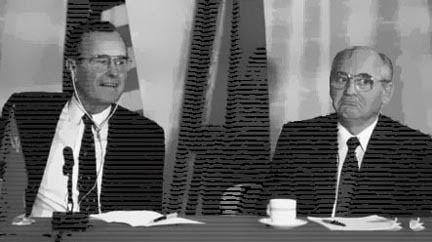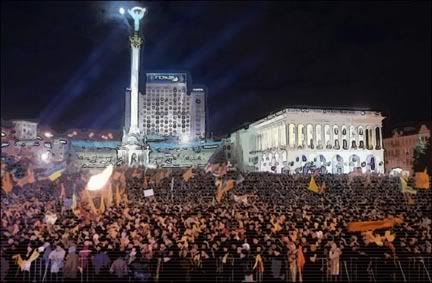Guerillas Without Guns/Chater 1
Poated 5/11/2007
One of the prime avenues for containing and steering the power of the EU into conformity with the Anglo-American Alliance was the North Atlantic Treaty Organization (NATO). Also called “the Western Alliance:” the US, UK, Belgium, France, et al, NATO was the grand World War II Alliance minus the USSR. After forming in 1949, NATO took in Greece and Turkey (1952), and then West Germany (1955), but afterwards sat steady for decades as it stared Moscow down, never used its mutual defense clause, and remained a potential military force only.
Yet despite the final crumbling of the Warsaw Pact and even the USSR itself, the objects of its vigilance, NATO remained and looked for a new mission. In a 1992 Pentagon report leaked before scrubbing, then Undersecretary of Defense for policy Paul Wolfowitz offered a role for NATO if not a mission. The report admitted “we must seek to prevent the emergence of European-only security arrangements which would undermine NATO, particularly the alliance’s integrated command structure.” This command structure keeps the United States in the loop so that the Europeans could not make military or security decision the US was unwilling to sign off on. Indeed, Wolfowitz noted how this arrangement would allow NATO to remain “the primary instrument of Western defense and security as well as the channel for U.S. influence and participation in European security affairs.” [1]
CFR heavyweight and former National Security Adviser Zbigniew Brzezinski saw the same role for NATO. In his 1997 strategic tome The Grand Chessboard, he took a placating line that the organization’s leadership should eventually give Europe a greater role, coequal with Washington in a 1+1 (US + EU) formulation. While he noted the existing “American primacy within the alliance,” European membership was set to grow, and thus “NATO will have to adjust.” [2] But in an accompanying article for Foreign Affairs, the official publication of the CFR, he wrote more frankly:
“With the allied European nations still highly dependent on US protection, any expansion of Europe's political scope is automatically an expansion of US influence. […] A wider Europe and an enlarged NATO will serve the short-term and longer-term interests of US policy. A larger Europe will expand the range of American influence without simultaneously creating a Europe so politically integrated that it could challenge the United States...” [3]
To date, NATO remains Europe’s only credible security force, is now in fact waging wars over its member’s interests while expanding its member list (and therefore possible conflict trigger-points), and the US has consistently promoted European expansion, especially the CFR people.
Who exactly is pulling whose strings in this arrangement is a matter of contention. Some, like John Laughland, would argue that Europe has thus been made the “51st state of America,” [4] while some Americans claim their country has been “Europeanized” as the economic powerhouse to bolster the European order. More likely neither side holds the reins exclusively, and a carefully managed confluence of interests is the wellspring of this trans-Atlantic union we call the West. Either way, regarding Russia and its sphere, it can be treated as a unified and hungry whole. Upon the USSR's collapse, if not before, the West set to wooing the former Warsaw Pact states; Internal political and economic reforms, once verified, could lead to inclusion in the solidifying EU and even NATO, then taking new applications as it considered its new agenda.
It was known Russia could not react favorably to NATO expansion, as noted in a 1995 analysis by Alexei K. Pushkov, onetime adviser and speech-writer for Premier Gorbachev, an eminent Russian mind. The report was published in Strategic Forums, an offshoot of National Defense University in Washington, and warned that NATO expansion into Eastern Europe or beyond would lead to seven key problems. Pushkov listed among these: “deepening of the gap between Russian and Western civilizations,” “an unwelcome influence on internal Russian politics,” and “a rebirth of the Russian sphere of influence among the former states of the Soviet Union.” On this point, he explained “if Russia considers itself geopolitically cut off from Europe and the Euro-Atlantic community, it would have no choice but to strengthen its historical sphere of influence.” [5]
Most ironically, Pushkov predicted, the expansion of this tool of Western security could well lead to “a weakening of overall European security” by expanding the number of NATO’s mutual defense trigger points while simultaneously increasing the tensions with Russia over those, and by encouraging “a new militarism in Russia.” Expansion would surely be seen in Moscow as an unfriendly act of distrust, no matter the spin put on it, and could cause Russia “to become a more independent player, less constrained by a real or illusionary partnership with the West.” Pushkov warned “Russia might well become a loose cannon in world politics” with “very serious” effects on world stability.
Yet in March 1999 the NATO blithely accepted applications from former Warsaw Pact states Poland, Hungary, and the Czech Republic, expanding its geographic scope greatly at the expense of Russia’s recent sway. Others got in the queue; Latvia, Lithuania, and Estonia, the last Republics fused into the USSR and first to leave, ran away and joined this circus. A later round of NATO additions in March 2004 scored all three, its first former SSRs, along with Romania, Bulgaria, Slovakia, and the alliance’s first former Yugoslav republic, Slovenia.

left: NATO states vs. Warsaw Pact in 1988, Iron Curtain highlighted.
right: NATO vs. Russia’s sphere (CIS) in mid-2004
During the Cold War the West always maintained they propped up the Iron curtain to keep the Soviet wolf at bay – in its time that may have been true, but once the fence fell, every bit of devouring has been in an easterly direction as the Euro-Atlantic community expands deeper into Eurasia and what was being called the post-Soviet Space, with Russia’s influence receding like a melting glacier.
Next: Gene Sharp: Master of Noviloent Warfare
Sources:
[1] Tyler, Patrick E. "US Strategy Plan Calls for Insuring No Rivals Develop A One-Superpower World: Pentagon’s Document Outlines Ways to Thwart Challenges to Primacy of America." The New York Times. March 8, 1992.
http://work.colum.edu/~amiller/wolfowitz1992.htm
[2] Brzezinski, Zbigniew. "The Grand Chessboard: American Primacy and its Geostrategic Imperatives." New York. Basic Books. 1997. First Printing. Page 76
[3] Zbigniew Brzezinski, "A Geostrategy for Eurasia," Foreign Affairs, 76:5, September/October 1997.
http://www.comw.org/pda/fulltext/9709brzezinski.html
[4] Laughland, John. “Becoming the 51st State.” Antiwar.com. May 20, 2003
http://antiwar.com/laughland/?articleid=2071
[5] Pushkov, Alexei. "NATO Enlargement: A Russian Perspective." Strategic Forums. July 1995. http://www.ndu.edu/inss/strforum/SF_34/forum34.html




